Anti Tubercular Agents Introduction
Tuberculosis
It is a disease of respiratory transmission. A person gets infected when he comes in contact with an environment contaminated with viable tubercle bacilli. It spreads through coughing, sneezing, and shouting of an infected person.
Causative Organism: Mycobacterium Tuberculosis
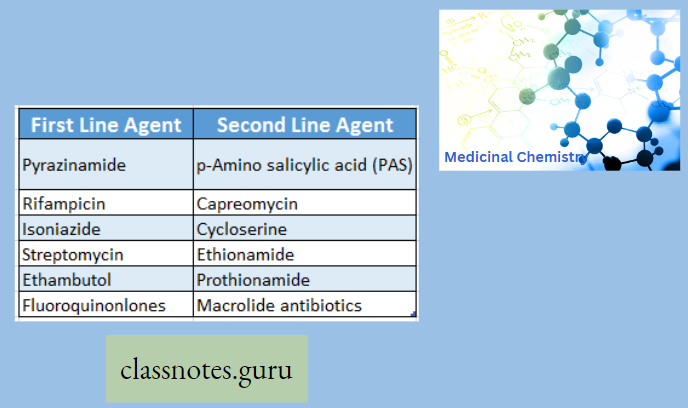
Isoniazid
It is a hydrazide of iso-nicotinic acid.
- The structure of INH is similar to Pyridoxine (Vit B6).
- Bacteriostatic in action
Mechanism Of Action: INH inhibits Mycolase Synthase, an enzyme necessary for the biosynthesis of mycolic acid (essential constitute of the mycobacterial cell wall).
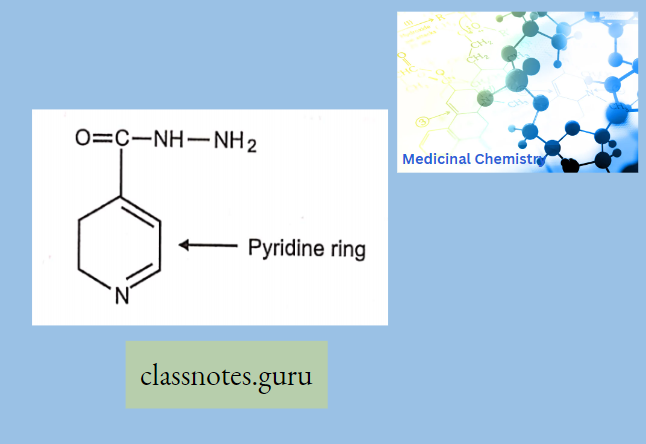
Metabolism: N-acetylation, depends upon the transfer of the acetyl group from coenzyme A by N-acetyl transferase.
- The rate of acetylation is genetically controlled.
- Acetyl hydrazine: Toxic metabolite of INH which is responsible for hepatotoxicity.
Metabolism Adverse Effect:
- Peripheral Neuritis-Co administration of Pyridoxine (Vit B6) with INH prevents the symptoms of peripheral neuritis.
- GIT disturbance (Constipation, Loss of appetite)
- Hepatotoxicity
Read and Learn More Medicinal Chemistry III Notes
Metabolism Drug Interaction:
- Antacid (Aluminum Hydroxide) Inhibits the absorption of INH.
- PAS-Inhibits metabolism.
- INH also inhibits the metabolism of Phenytoin and carbamazepine.
Streptomycin
Aminoglycoside antibiotic
- Bacteriostatic in action
- Used always in combination
- Nephrotoxicity and ototoxicity are major side effects.
- Streptomycin resistance strain treated with kanamycin and viomycin.
Ethambutol Or Myambutol

- The activity of EMB is stereospecific, dextro isomer having maximum activity than the levo form.
- It has two chiral centers.
Mechanism Of Action:
It inhibits the “Arabinosyl transferase enzyme” to prevent the polymerization of arabinoglycan in the mycobacterial cell wall.
- Ethambutol if used in a dose of 25 mg/kg per day for more than 9 months can cause Reterobulbar Neuritisimpairment of visual activity and red-green color discrimination.
- Ethambutol decreases renal excretion and it may produce gouty arthritis.
- Contraindicated in pregnancy and children below 2 years.
- A monthly eye examination of the patient is necessary when the patient is treated with EMB.
Rifampicin
Rifampicin is an orally active bactericidal semi-synthetic derivative of rifamycin B.
- Rifampicin is obtained from Streptomyces mediterranei.
- Rifampicin is also known as Ansamycin antibiotics.
Rifampicin Mechanism of Action: It strongly binds to the p subunit of bacterial ‘DNA dependent RNA polymerase’ enzyme. Thereby inhibits the RNA synthesis of bacteria. Mammalian RNA polymerase does not bind to rifampicin.
Rifampicin Adverse Effect:
- Hepatitis risk may increase when used in combination with INH.
- The flu-like syndrome is characterized by fever, chills, myalgias, and thrombocytopenia.
- Rifampicin imparts a harmless red-orange color to urine.
Rifampicin Drug Interaction: Rifampicin has enzyme induction properties and hence accelerates the metabolism of several drugs like oral contraceptives, anti-coagulants, and protease enzymes.
Pyrazinamide
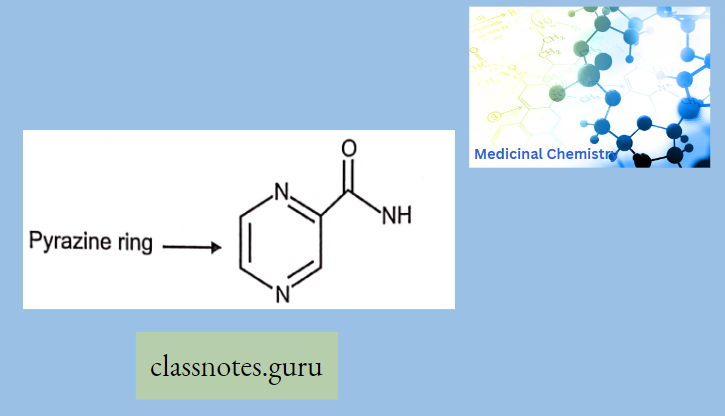
- It is a pyrazine analog of nicotinamide (containing a pyrazine ring).
- Principle metabolites are Pyrazinoic acid (Active metabolite) and 5-Hydroxy pyrazinoic acid.
Pyrazinamide : (PZA) Mechanism of Action: PZA enters the cell wall of M. tuberculosis via passive diffusion and it is converted to pyrazinoic acid (Active metabolite) by pyrazinamidase enzyme. Then later it inhibits mycobacterial fatty acid synthase-I enzyme and disrupts mycolic acid synthesis needed for mycobacterium cell wall synthesis.
Second Line Agent
Ethionamide:
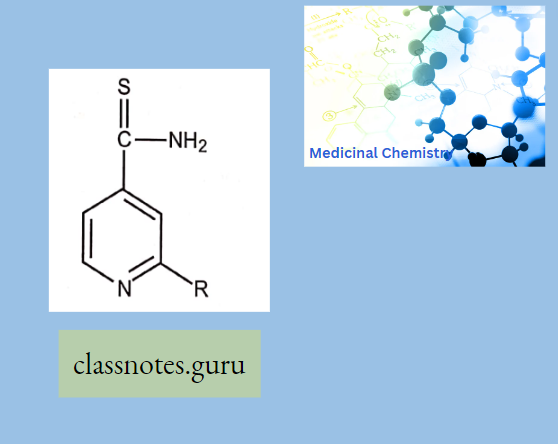
R = -C2H5 = Ethionamide 2 – ethyl thiosonicotinamide
R = -C3H7 = Prothionamide-2-propyl thiosonicotinamide
- Prothionamide Or Ethionamide are congeners of this nicotinamide.
- It is also known as the Thioamide analog of Isoniazide.
Ethionamide Mechanism Of Action: It may interfere with peptide synthesis by acting as an antimetabolite and inhibiting the incorporation of sulfur (-SH) containing amino acids. (Cysteine, methionine)
P-Amiito Salicylic Acid:

- Because of its sour taste and irritant nature, this drug is mainly used in the form of its Na+, K+, and Ca+ salts.
Mechanism Of Action: Same As Sulphonamide
Sulphonamide Adverse effect
- Crystalluria
- Lupas like syndrome
- GIT irritation
Thiacetazone:

Chemically, it is a thiosemicarbazone derivative.
Cycloserine:
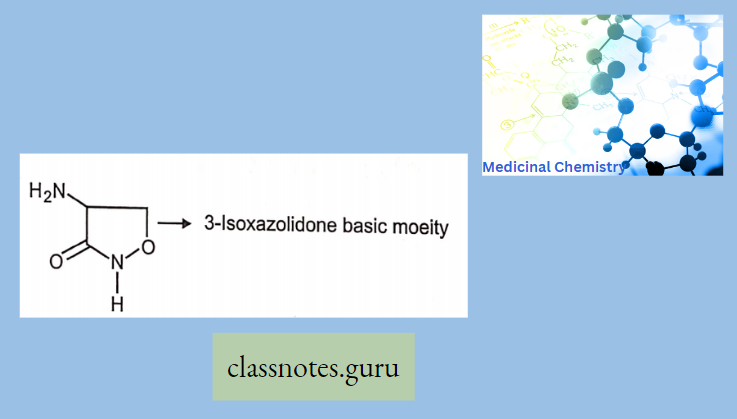
- Analog of D alanine
- Chemically, D-4-amino 3-isoxazolidone.
- Broad spectrum antibiotics.
- Steriochemically similar to D-Serine.
Cycloserine Adverse Effect
- Peripheral Neuritis
- Tremors
- Psveotlc
- Behavioral changes
Synthesis Of Isoniazid
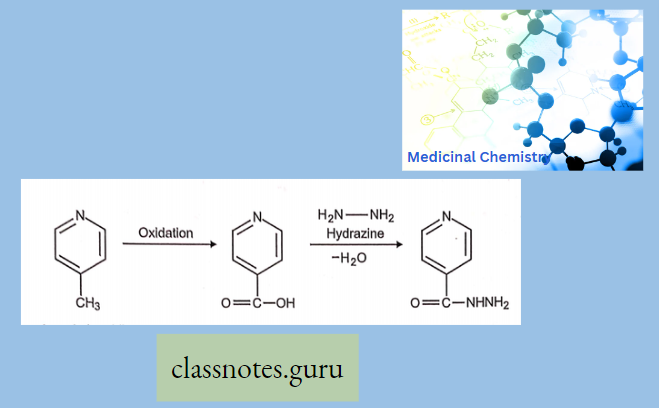
Synthesis Of Para Amino Salicylic Acid
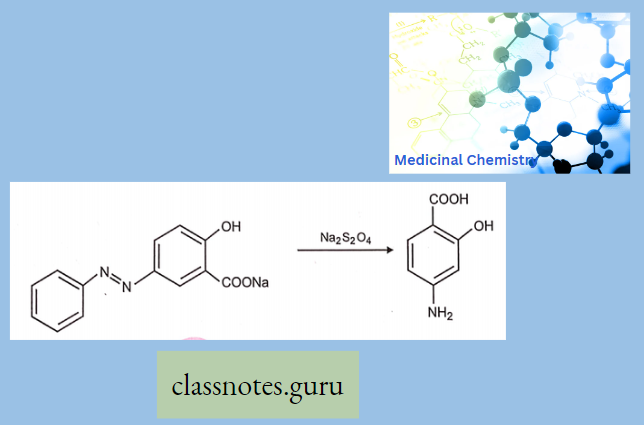
Anti Tubercular Agents Multiple Choice Question And Answers
Question 1. Isoniazid is
- Pyridine derivative
- Trioxane derivative
- Guanidine derivative
- None
Answer: 1. Pyridine derivative
Question 2. Isoniazid act on
- Mycolic acid
- Arabinose galactose
- Cox
- All
Answer: 1. Mycolic acid
Question 3. Ethambutol act on
- Mycolic acid
- Arabino galactose
- Cox
- All
Answer: 2. Arabino galactose
Question 4. Neurotoxicity is the adverse effect of
- Isoniazid
- Ethambutol
- Both
- None
Answer: 1. Isoniazid
Question 5. Visualdisruotion Adverse Effect of
- Isoniazid
- Pyrazinamide
- Ethambutol
- None
Answer: 3. Ethambutol
Anti Tubercular Agents Short Question And Answers
Question. 1 Write the mode of action of isoniazid.
Answer:
Mode Of Action Of Isoniazid: INH inhibits Mycolase Synthase, an enzyme necessary for the biosynthesis of mycolic acid (essential constitute of mycobacterial cell wall).
Question .2 Write the mode of action of pyrazinamide.
Answer:
Mode Of Action Of Pyrazinamide
PZA enters me cell wall of M. tuberculosis via passive diffusion and it is converted to pyrazine acid (Active metabolite) by the pyrazinamide enzyme. Then later it inhibits mycobacterial fatty acid synthase-I enzyme and disrupts mycolic acid synthesis needed for mycobacterium cell wall synthesis.
Question. 3 Write the adverse effect of Cycloserine.
Answer:
The Adverse Effect Of Cycloserine
- Peripheral Neuritis
- Tremors
- Psychotic
- Behavioral changes
Question .4 Write the adverse effect of isoniazid.
Answer:
The Adverse Effect Of Isoniazid: Peripheral Neuritis-Co administration of Pyridoxine (Vit B6) with INH prevents the symptoms of peripheral neuritis. GIT disturbance (Constipation, Loss of appetite) Hepatotoxicity
Question .5 Write the mode of action of Rifampicin.
Answer:
The Mode Of Action of Rifampicin: It strongly binds to the [3 subunit of bacterial ‘DNA dependent RNA polymerase’ enzyme. Thereby inhibits the RNA synthesis of bacteria. Mammalian RNA polymerase does not bind to rifampicin.
Question 6. Write the adverse of Rlfamplcin.
Answer:
The Adverse Of Rlfamplcin: Hepatitis risk may increase when used in combination with INH. A flu-like syndrome is characterized by fever, chills, myalgias, and thrombocytopenia. Rifampicin imparts a harmless red-orange color to urine.
